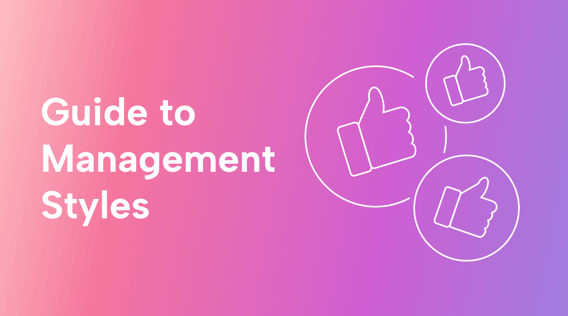Am I using the right management style? Could a different approach help my team perform better?
Ever had those thoughts? If so, here’s the good news:
Exploring different leadership styles is the first step to becoming a more effective manager.
One of the most pivotal choices in management is deciding whether to take a top-down or a bottom-up approach. Both have advantages, as well as challenges that could hold your company back.
Implementing the most appropriate management style for your business impacts your employees, customers, and bottom line.
In this post, we’ll define the top-down vs. bottom up-approaches to management. Then, we’ll explore which businesses tend to use which strategy, along with the pros and cons for each to help you find the best fit for you.
Ready to learn more? Let’s go.
What are the top-down and bottom-up approaches to management?
Top-down and bottom-up are two important management styles.
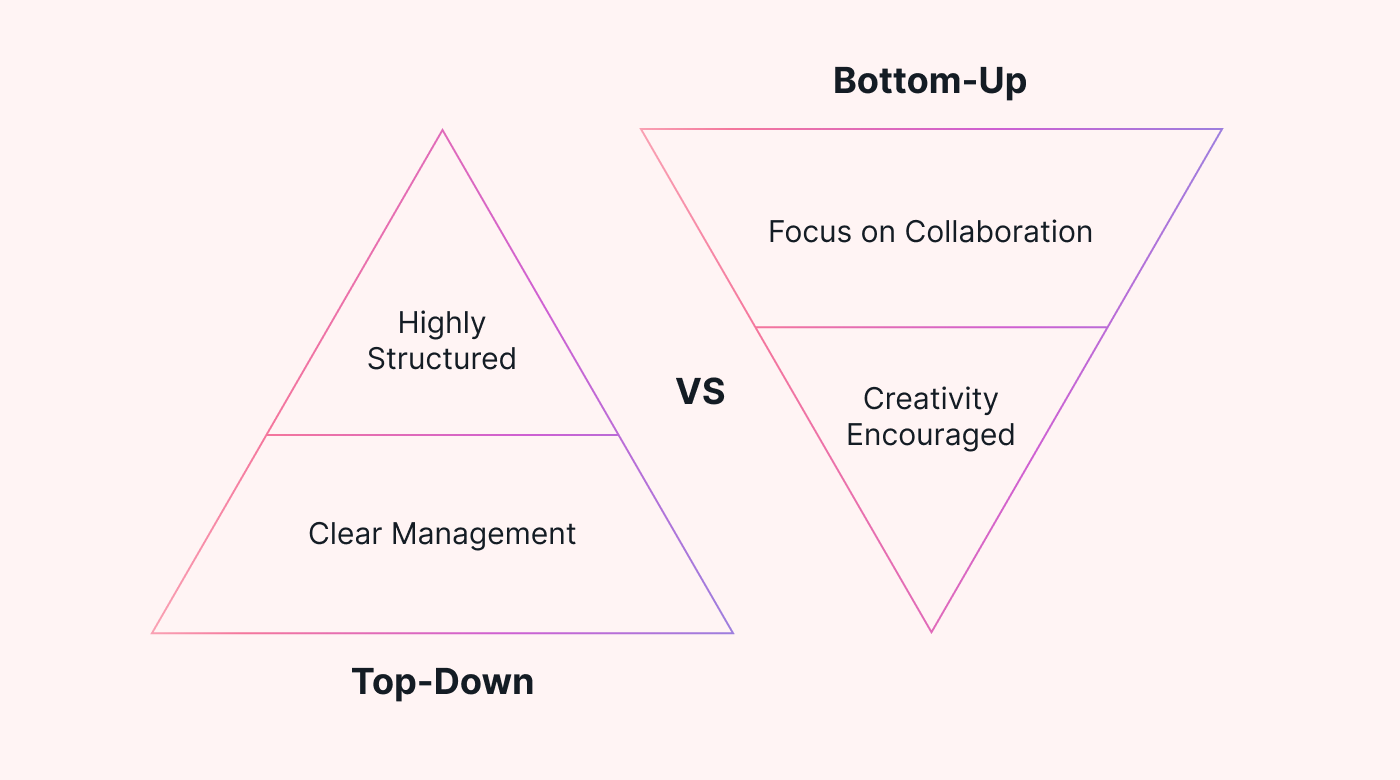 |
The top-down approach starts with upper management. A CEO, senior supervisor, or project manager makes the initial decisions regarding goals, processes, and projects. This information is communicated to the company’s individual departments for fulfillment.
With bottom-up management, team members are involved in all (or most) aspects of decision-making. Each person’s voice carries weight as the team decides on common goals or works together to complete a project.
These two approaches are very different. And the one you choose will substantially impact the way your team functions.
Let’s break down both styles and their pros and cons.
The top-down approach
The top-down approach is also called the “autocratic leadership” style.
This approach can apply to the company’s fundamental procedures and the specifics of its project management.
A few decision-makers drive the top-down approach.
For example, one decision-maker could be the CEO, who establishes goals for the company and outlines the processes needed to achieve them. It could also be a senior project manager who determines the timelines and steps required to manage a project successfully.
Once the decisions are made, that information, along with the expectations for completion, is sent to the team for execution.
In a top-down approach, team members are expected to carry out responsibilities with little room for adjustment or collaboration.
When would you use the top-down approach?
The top-down approach is favored by businesses and organizations that thrive with clear leadership and highly structured processes.
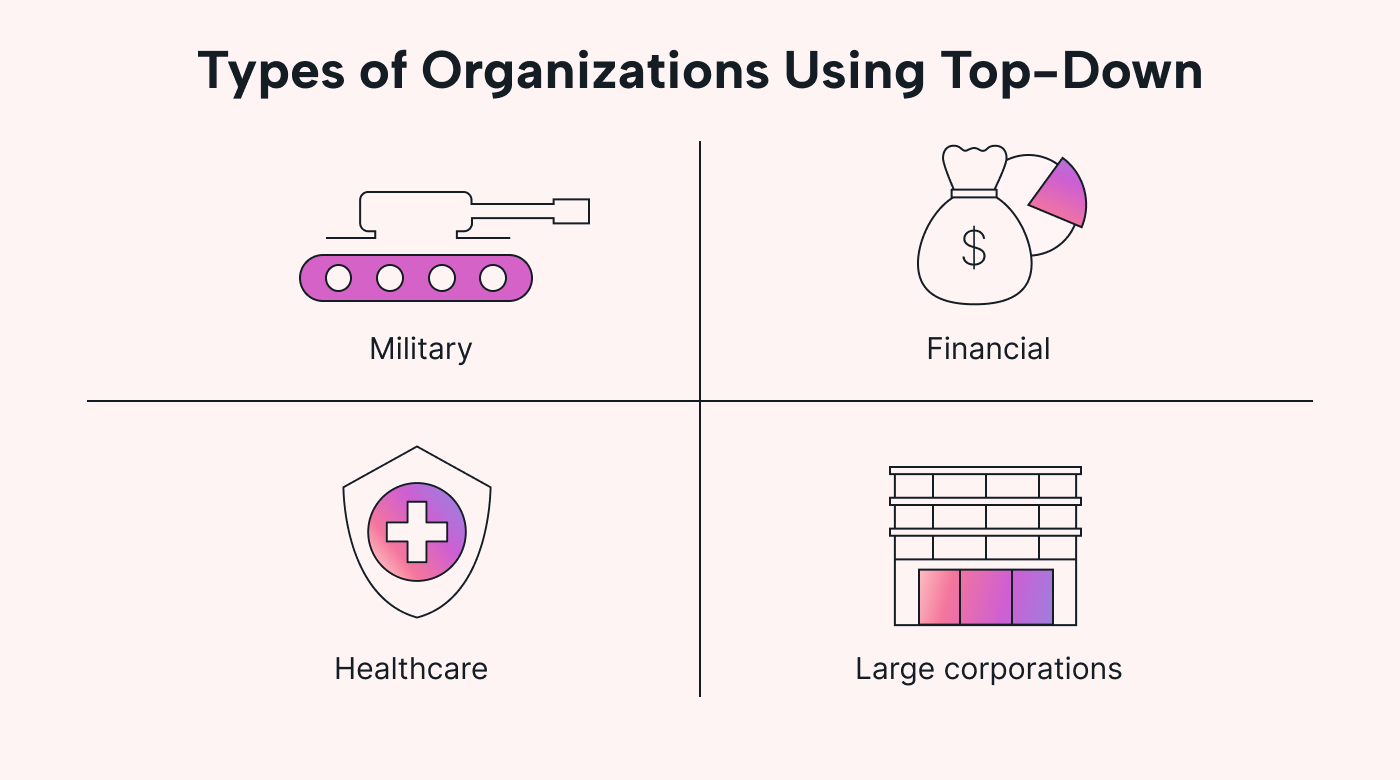 |
- The military is a prime example of top-down management. Decisions are made by the highest-ranking officers, and instructions are related to the rank and file. Compliance within a rigid structure is expected.
- The financial sector also uses top-down management. Banks, investment firms, and other financial institutions rely on carefully controlled processes for consistency within dynamic markets.
- The healthcare industry also widely employs this management style. Upper management implements research-based, standardized processes to support patient health and wellness.
- Large businesses or corporations often utilize top-down management approaches. Large-scale organizations may need the structure this approach provides to ensure the quality of their operations.
Top-down benefits
Top-down benefits start with strong leadership.
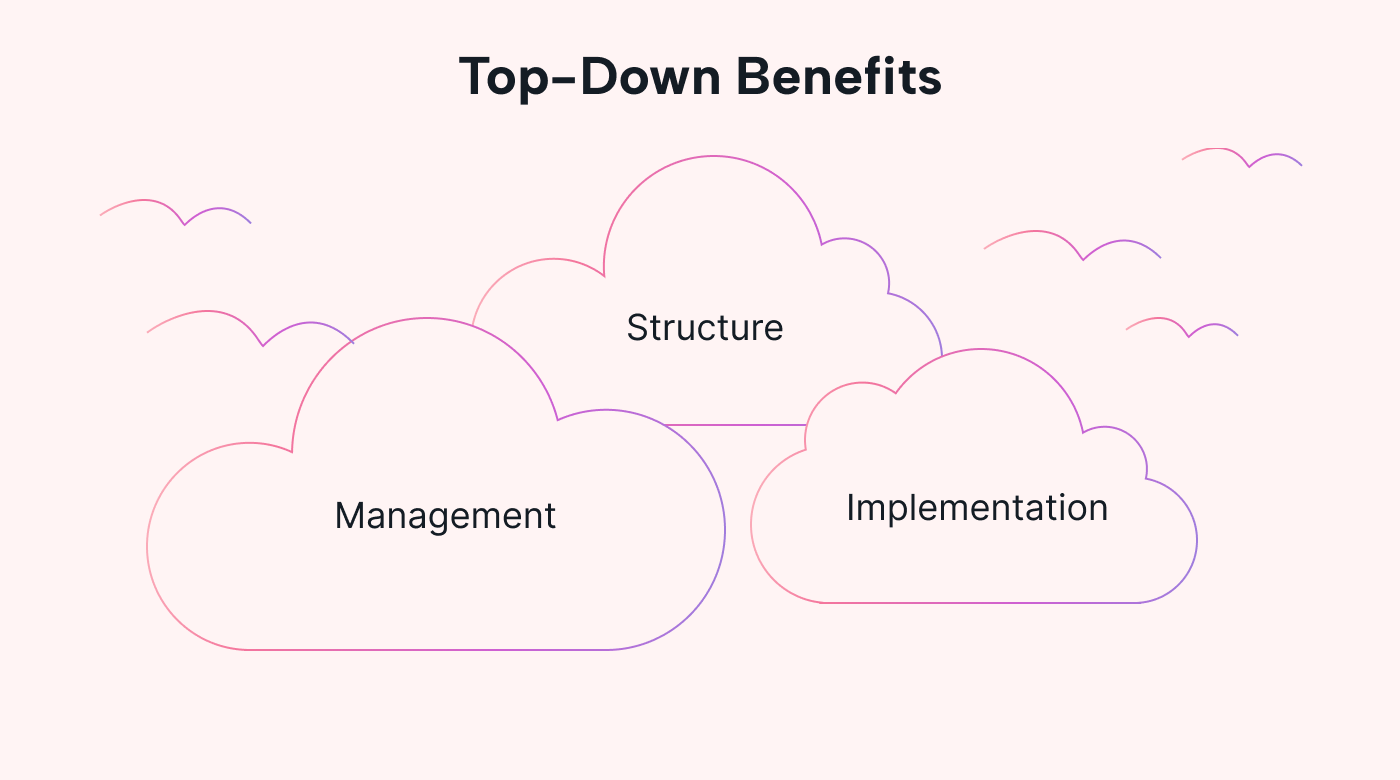 |
Clear management
In top-down management, roles and responsibilities are defined through a clear hierarchy. As a result, employees know who makes the decisions.
Highly structured
Companies that benefit from an enhanced structure may lean toward a top-down approach. This is because the goals and objectives, along with clear processes and guidelines for their completion, are established at the top.
Faster implementation
Goals assigned using a top-down approach can be implemented quickly. Neither collaboration nor information gathering is needed, so employees can carry out their tasks and responsibilities immediately.
Processes standardized
Companies that consistently use the top-down approach standardize processes and procedures over time. Employees can rely on consistency and clarity as they set out to achieve their goals.
Drawbacks
While the top-down approach is efficient, there are several disadvantages of the top-down approach that might impact your decision.
Less creativity and innovation
Decisions made by top leadership allow for little collaborative or creative input.
Businesses with rigid structures may have difficulty adapting to change, which negatively impacts innovation.
Decreased employee engagement
Employees who are unable to contribute ideas may not be invested in their positions. As a result, they might start to feel disengaged.
 |
Impacts of leadership
Strong leadership is important to an effective top-down approach, as it encourages company growth and contributes to a positive culture. Conversely, poor leadership often leads to weaknesses in goal-setting, process establishment, and company morale.
Limited opportunities for feedback
Limited opportunities for collaboration also lead to limitations with feedback. As management drives the decisions, it may take some time for them to hear concerns and adapt to challenges.
The bottom-up approach
Companies that employ the bottom-up management style start making decisions and formulating ideas at the ground level. While upper-level management or senior leaders might come up with the original goal or project, the company’s various teams work together to create the systems, processes, and steps for its completion.
When would you use a bottom-up approach?
Businesses that place a premium on creativity and innovation benefit from bottom-up management.
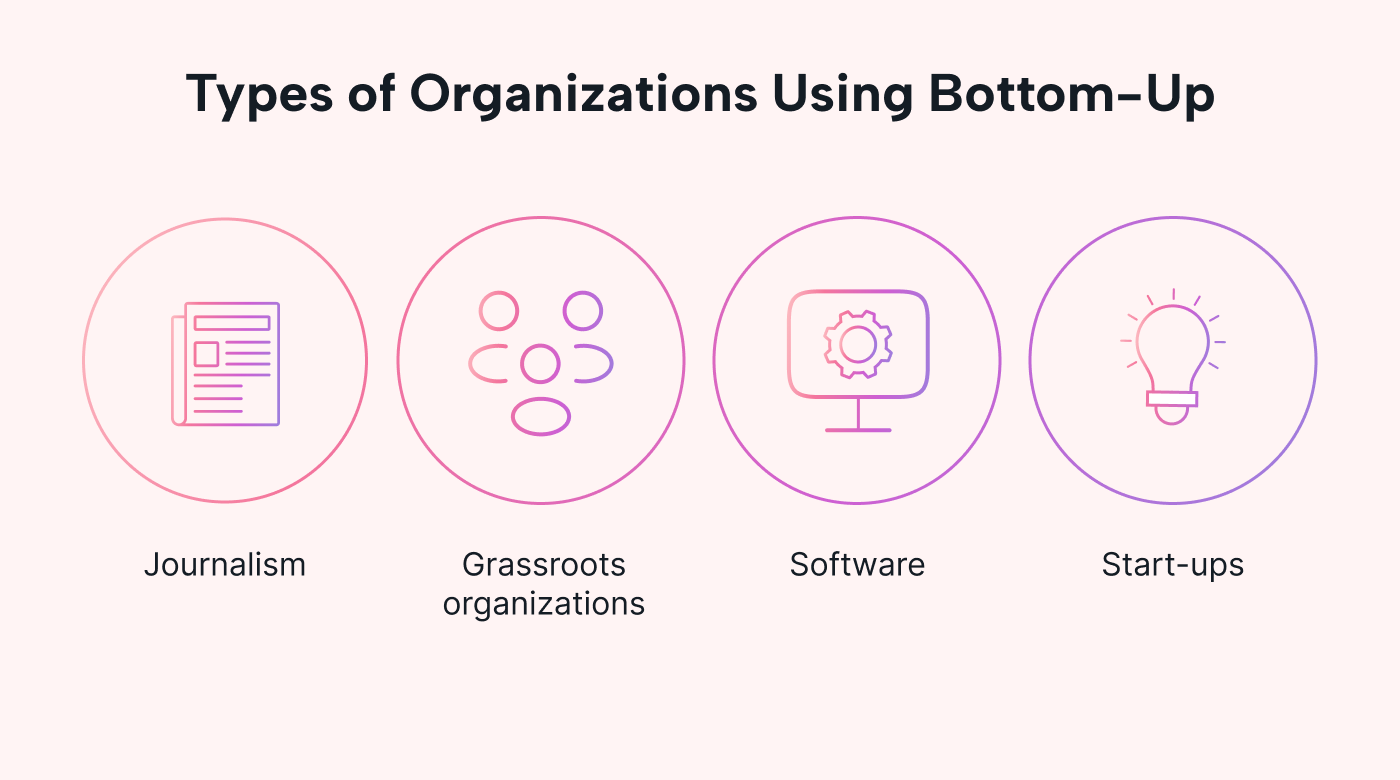 |
- Journalism thrives with ongoing collaboration and input from team members to deliver a highly accurate, quality product.
- Grassroots organizations tend to use a bottom-up approach. Smaller groups turn their collective ideas into plans of action to influence significant societal or cultural change.
- Software companies rely on innovation. A bottom-up approach ensures all members contribute to product development and advances.
- Start-ups are sometimes known as disruptors in their respective industries, and with good reason — they are attempting to innovate and add value to the market. As such, they often implement a bottom-up approach that encompasses high levels of collaboration.
Benefits to going bottom-up
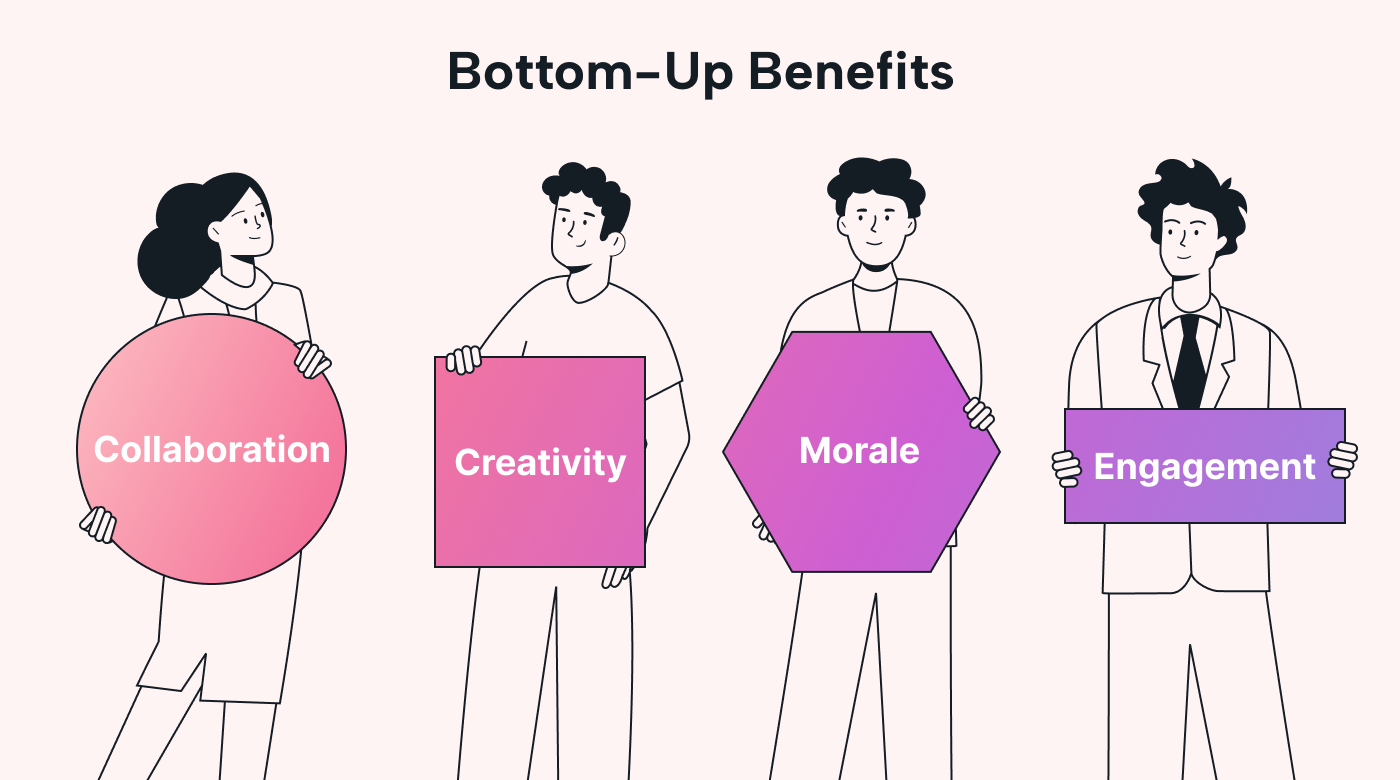 |
For some businesses, the benefits of the bottom-up approach are hard to ignore.
Elevated creativity and innovation
The bottom-up approach provides more opportunities for creativity. Different perspectives allow for added depth to process development and improved problem-solving strategies.
Innovation is valued, so members are encouraged to offer suggestions and take risks with their ideas.
Increased engagement and productivity
Employees who know their ideas will be considered are more likely to offer them in the first place. Increases in engagement can lead to an 18% increase in productivity.
Stronger employee morale
Increased engagement leads to stronger employee morale. Employees who can provide input tend to feel more positive about their roles, responsibilities, and assignments.
Greater collaboration and investment
Among high-performing teams, 55% report a high value on cross-collaboration and communication among members. Not only does the bottom-up approach support high collaboration, but it also encourages it across the rest of the organization.
Drawbacks of bottom-up
Before switching your management style to this creativity-driving approach consider whether the following disadvantages of bottom-up management would negatively influence your business:
Lack of high-level input
Team members who are charged with goal setting and processes may not always have the broad understanding that comes from higher management levels. As a result, they might not make the most strategic or practical decisions.
Employees who are unaware of over-arching company goals, budgetary issues, and performance metrics cannot apply them to their plans and processes moving forward.
Slowed momentum
The more people collaborating on a project, the slower it may progress. More input and ideas slow momentum, especially if members cannot come to a decision.
Decreased clarity
If all team members provide equal input, it might be challenging to determine an outcome. In addition, a lack of clear leadership can lead to confusion about assignments, project steps, and deadlines.
Increased mistakes
When decisions are spread across all members, there’s usually less organization. It also might not be clear where final-approved information lives and how to access it. Mistakes can happen more frequently and without clear accountability.
Which style is right for you?
Both of these management styles offer clear advantages and disadvantages.
As you decide which one to adopt for your business, here are some additional factors to keep in mind:
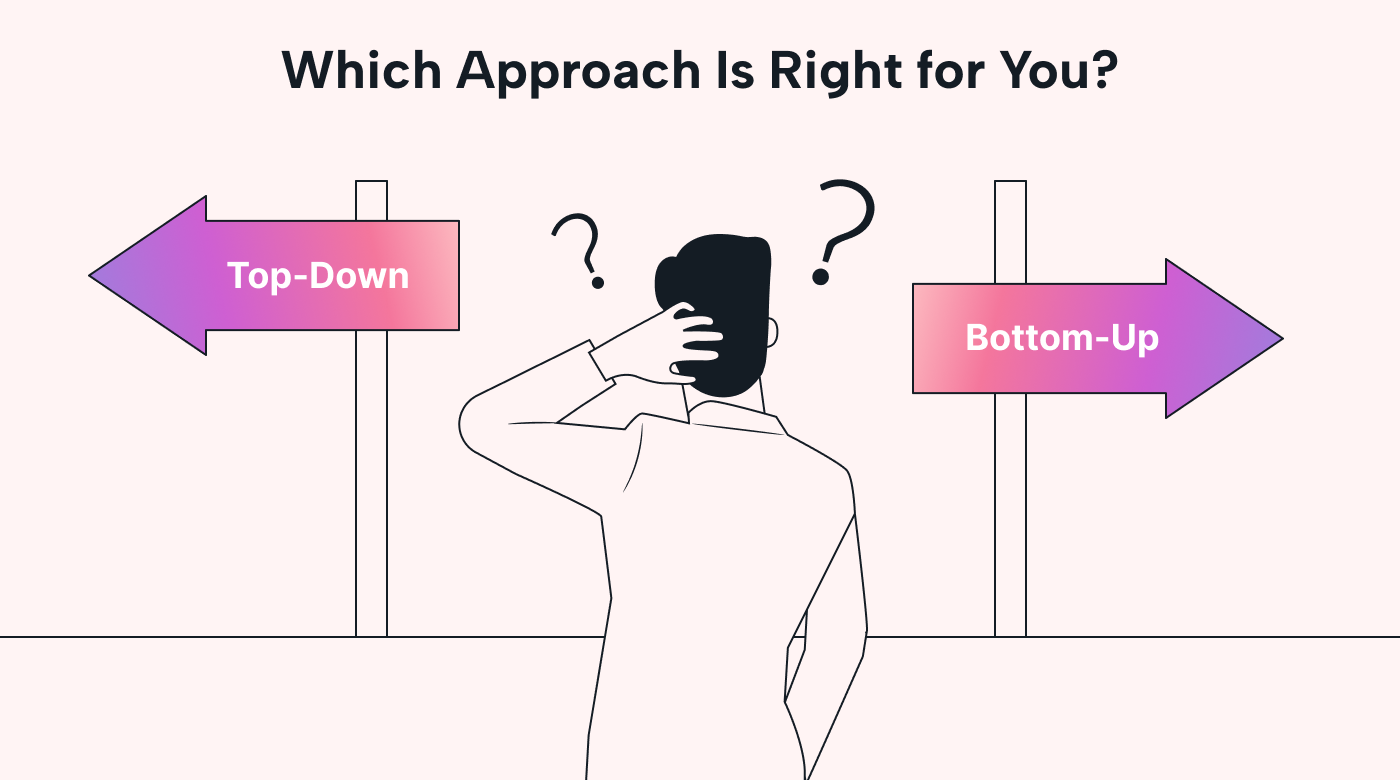 |
- Consider your culture. If you value high levels of creativity and innovation, a bottom-up approach will serve your business better.
If your business depends on highly structured processes to deliver products and outcomes, then you might lean toward the top-down style instead.
- Think about your size. If you are a start-up with plans to scale, you might want each member’s input and collaboration as you grow.
Larger organizations, however, may need consistent and refined processes to keep multiple teams on track and in sync.
- Remember your goals and objectives. Go back to the basics. What are you seeking to do? What products are you delivering? How quickly do you need to innovate?
Consider your baseline goals and objectives to determine if you need an autocratic top-down or collaborative bottom-up approach to deliver.
- Consider going hybrid. No rule states you must choose one management approach or the other.
Maybe you’re interested in a combination.
If you need a clear leadership structure from the top-down approach, implement it. But then, build opportunities for team member collaboration and feedback where you can. Regular feedback will ensure you hear about new perspectives and ideas for problem-solving.
If you prefer the collaborative, integrated, bottom-up approach, go for it. But assign one or two members for leadership roles within the project. Ensure your company goals and objectives are readily available when members plan projects and develop the next steps.
Approach your management style with confidence
Now you know more about the top-down vs. bottom approaches to management.
You know the different types of organizations that employ these styles and why, as well as the benefits and drawbacks of each.
Now it’s time to decide which option is right for you.
Do you own a smaller business or start-up?
Do you manage employees who thrive with collaboration and creativity?
Do you need to set clear guidelines with little opportunity for input or debate?
Maybe you need some of both.
Take what you’ve learned about each of these approaches to see how you might apply them to your business.
Use Motion to help you. Motion provides the tools you need to build your schedule and manage your projects in one easy place, no what management style you use.
Get to it!

